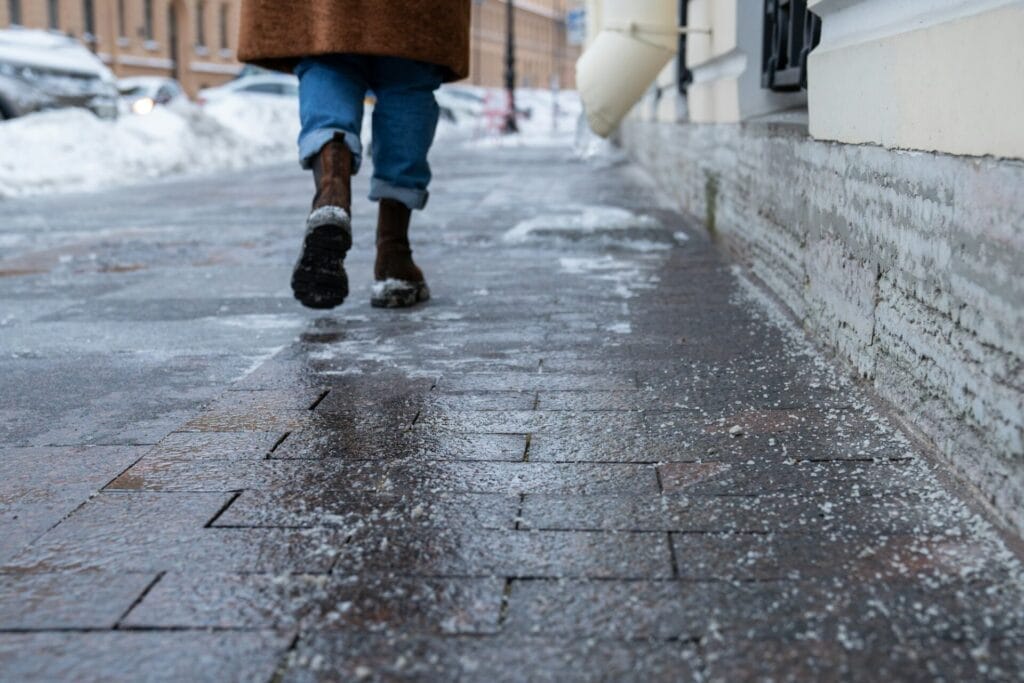With our Canadian February comes snow and melting and freezing temperatures, which means ice, slush and so many places to beware of a slip and fall!
As private residential homeowners or tenants (occupiers), we are responsible for shovelling and salting our driveways and walkways to ensure the safety of persons who enter onto our property for lawful purposes such as mail carriers, couriers, visitors or emergency personnel (EMS, firefighters or police). Failure to do so can attract liability to the homeowner (hopefully covered by their homeowner insurance) if someone is injured due to a slip and fall while on your property. This is similar to a commercial property, where owners of stores and businesses are responsible for any slip and falls that occur on their property or parking lot due to failure to clear snow, ice or similar hazards. However, there is a greater expectation of timeliness and thoroughness, as well as ta greater duty to warn of hazards, for commercial property owners or tenants than that of private residential property owners or tenants. The legislation that governs this is the Occupiers Liability Act.
In addition to a homeowner’s property, Kamloops’ Road Right-Of-Way Bylaw requires that we also clear the sidewalks or footpaths adjacent to our residential properties of accumulated snow, ice or rubbish to the extent that it impedes pedestrian traffic. Although not included in the Bylaw, the City website indicates that it is also the responsibility of the homeowner or tenant to clear the windrow (the snow the road plow leaves behind) at the end of the driveway. Note, there is a volunteer program in Kamloops called Snow Angels that pairs neighbourhood-based volunteers with residents who are mobility impaired or seniors to assist with snow removal.
The City can warn and then clear the snow themselves and fine or otherwise penalize a homeowner or tenant for failure to remove the snow from adjacent sidewalks or pathways.
However, if the homeowner or tenant does not clear the snow and ice on the adjacent city property (sidewalk or pathway) and someone is injured in a slip and fall, the BC Court of Appeal in a 2021 case called Der v. Huang unanimously held that the property owner “does not owe a general duty of care to take reasonable care with respect to the removal of snow and ice from sidewalks adjacent to their property.” The Court held that even when municipalities enlist residents to assist with snow-clearing by enacting a Bylaw, it does not shift the legal liability or duty of care to the homeowner. The duty of care remains with the city or municipality who may then be liable to the injured party. The Supreme Court of Canada confirmed the liability of a city or municipality for injuries caused due to the City’s snow clearing and removal decisions in a 2021 decision called Nelson (City) v. Marchi.
It is very important to note that if you are injured on a city, municipal or regional district sidewalk or pathway, the Local Government Act states you must report the incident and injuries to the city in writing “within 2 months from the date upon which the damage was sustained”. If you fail to do so in that time period, the city is not liable for your injuries except in a very narrow set of circumstances. The first step may be to send an email with the date and location of the slip and fall as well as details of your injuries to .
It can be very helpful to contact a lawyer immediately upon realizing you are injured to assist you and ensure that you comply with the reporting requirements, collect any evidence (such as photos at the scene and of your footwear) and preserve your right to make a claim for any damages you may sustain as a result of your slip and fall. As well, they can advise you on the various steps to your claim and what damages you may be entitled to.
If you have questions and would like a consultation, or for more information, please contact Priddle Law Group at (250) 434-8911 or email to make an appointment.

